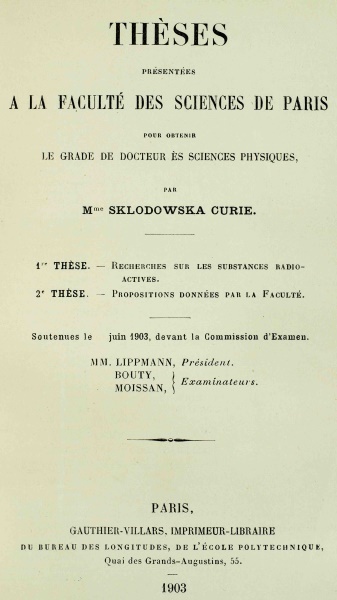Curie: ‘Thèse de Marie Curie’
Marie Curie’s 1903 doctoral thesis, Recherches sur les substances radioactives, earned her both a degree and considerable recognition from the scientific community. The thesis advanced Henri Bacquerel’s study of radioactivity. For the project, Curie searched for radioactivity in various substances and eventually isolated two previously unknown elements: polonium and radium.
Curie’s work with radioactivity has had a lasting impact on various scientific disciplines. She introduced X-rays into battlefield medicine in World War I, and her work continues to influence medical research and treatments to this day. Radioactivity has been used to trace chemical changes and life processes, to date ancient archaeological findings, and to ascertain the age of the earth itself.
Marie Curie’s thesis committee declared the work “the greatest contribution to science ever made by doctoral research.” Yet Curie’s thesis was just the beginning of the contributions Curie would make to science in her lifetime. She continued her study of radioactivity, eventually winning two Nobel Prizes and becoming a professor at the Sorbonne. — Mark Masthay, PhD, associate professor and chair of chemistry
Mark Masthay, chair of the chemistry department, discusses the significance of Marie Curie's research. Interview is an online supplement to the University of Dayton exhibit Imprints and Impressions: Milestones in Human Progress—Highlights from the Rose Rare Book Collection, held Sept. 29 through Nov. 9, 2014.
Sources
“Curie, Marie.” Leaders Of The Information Age (2004): Biography Reference Bank (H.W. Wilson). Web. 22 Apr. 2014.
“The Discovery of Radium.” Printing and the Mind of Man: Catalogue of a Display of Printing Mechanisms and Printed Materials, Arranged to Illustrate the History of Western Civilization and the Means of the Multiplication of Literary Texts since the XV Century. London: F.W. Bridges, 1963. 104. Print.
“Marie Curie – Facts.” Nobelprize.org. Nobel Media AB 2013. Web. 22 Apr 2014. “The Nobel Prize in Chemistry 1911.” Nobelprize.org. Nobel Media AB 2013. Web. 22 Apr 2014.

